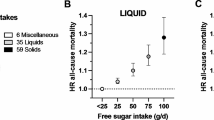Summary
Phenolic acids, essentially hydroxycinnamic acids and hydroxybenzoic acids, are secondary plant products and commonly found in plant derived foodstuff. The antioxidant and anticarcinogenic properties of phenolic acids could be one of the facts to explain the inverse association between fruit and vegetable intake and the incidence of coronary heart disease and cancer, respectively, as found in epidemiologic studies. Phenolic acids are rarely listed in food composition tables and there are no dietary intake data available. Consequently, a data base containing the phenolic acid content of foods (literatur data) was built and 7-d dietary protocols of 63 women and 56 men of a Bavarian subpopulation (age 19–49 years) of the German National Food Consumption Survey (NVS) were evaluated.
The average phenolic acid intake of men and women is 222 mg/d within a large range. The dominating one within all the phenolic acids is clearly caffeic acid (206 mg/d); the intake of the other phenolic acids amounts to 0.2 (gentisic acid) up to 5.2 mg/d (ellagic acid). The sum of hydroxybenzoic acids and hydroxycinnamic acids amounts to 11 mg/d and 211 mg/d, respectively. Significant sex differences are found for some of the phenolic acids. Especially, the average intake of caffeic acid of women (229 mg/d) is higher than that of men (179 mg/d) caused by the high amount of coffee consumption. The age group “25–49 years” is consuming more coffee than the age group “19–24 years” and, therefore, reveals a significantly higher intake of caffeic acid. The major sources of phenolic acids are coffee with 92% of the caffeic acid intake and fruits (including fruit products and juices) with 75% of the salycilic acid and 59% of the p-coumaric acid intake.
Consequently, phenolic acids are consumed in considerable amounts with food. Since antioxidant and anticarcinogenic properties of phenolic acids are already proven in in vitro as well as in animal experiments, epidemiologic studies will show whether a high phenolic acid intake goes ahead with a reduced risk for coronary heart disease or cancer in humans.
Zusammenfassung
Phenolsäuren, im wesentlichen Hydroxyzimtsäuren und Hydroxybenzoesäuren, sind als sekundäre Pflanzenstoffe in Lebensmitteln pflanzlichen Ursprungs weit verbreitet. Aufgrund ihrer antioxidativen und antikanzerogenen Wirkung könnten sie an der koronar- und krebsprotektiven Wirkung einer an Obst und Gemüse reichen Ernährung beteiligt sein. Angaben zum Gehalt von Phenolsäuren in Lebensmitteln sind kaum in Nährwert-Tabellen enthalten, Zufuhrdaten sind nicht bekannt. Deshalb wurden mit Hilfe einer neu erstellten Datenbank zum Phenolsäuregehalt von Lebensmitteln (Literaturwerte) 7-Tage Ernährungsprotokolle von 63 Frauen und 56 Männer eines bayerischen Teilkollektivs (Alter 19–49 Jahre) der Nationalen Verzehrsstudie ausgewertet.
Die mittlere Phenolsäure-Zufuhr des Gesamtkollektivs beträgt 222 mg/d bei einer relativ großen Schwankungsbreite. Unter den betrachteten Phenolsäuren dominiert die Kaffeesäure (206 mg/d), die Zufuhr der anderen Phenolsäuren bewegt sich zwischen 0,2 (Gentisinsäure) und 5,2 mg/d (Ellagsäure). Die Summe der Hydroxybenzoesäuren beträgt 11 mg/d und die Summe der Hydroxyzimtsäuren 211 mg/d. Für die mittlere Zufuhr mehrerer Phenolsäuren sind signifikante Geschlechtsunterschiede vorhanden. Insbesondere für die mittlere Kaffeesäurezufuhr sind die Werte der Frauen (229 mg/d), bedingt durch den höheren Kaffeekonsum, größer als die der Männer (179 mg/d). In der Altersgruppe “25–49 Jahre” wird mehr Kafee getrunken als in der Altersgruppe “19–24 Jahre” und somit signifikant mehr Kaffeesäure aufgenommen. Die wichtigsten Zufuhrquellen der Phenolsäuren sind der Kaffee mit 92% der Kaffeesäurezufuhr und die Lebensmittelgruppe Obst/-produkte/-säfte mit 75% der Salicylsäure- und 59% der p-Cumarsäure-Zufuhr.
Phenolsäuren werden somit in beträchtlichen Mengen mit der Nahrung zugeführt. Nachdem sowohl in vitro als auch im Tierversuch antioxidative und antikanzerogene Wirkungen von Phenolsäuren nachgewiesen wurden, bleibt es epidemiologischen Studien überlassen, ob sich ein Zusammenhang zwischen phenolsäurereicher Ernährung und vermindertem Risiko für koronare Herzerkrankungen und Krebs beim Menschen bestätigen läßt.
Similar content being viewed by others
Author information
Authors and Affiliations
Additional information
Eingegangen: 22. September 1997, Akzeptiert: 9. Dezember 1997
Rights and permissions
About this article
Cite this article
Radtke, J., Linseisen, J. & Wolfram, G. Phenolsäurezufuhr Erwachsener in einem bayerischen Teilkollektiv der Nationalen Verzehrsstudie. Z Ernährungswiss 37, 190–197 (1998). https://doi.org/10.1007/s003940050016
Published:
Issue Date:
DOI: https://doi.org/10.1007/s003940050016




